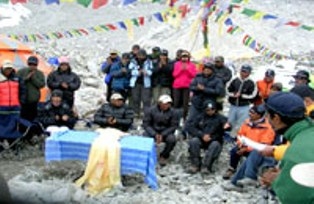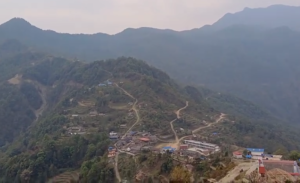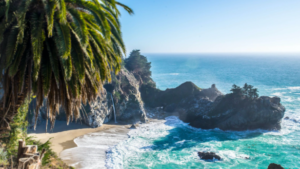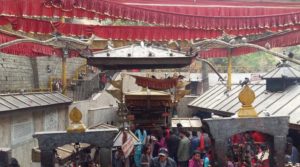Is Nepal Ready for the Growth of Tourism?

Laura Chapman —
Known for its mountain expeditions, rafting, and trekking, Nepal is quickly growing into one of the hottest adventure tourist destinations around the world. Mount Everest is without a doubt Nepal’s greatest claim to fame. As more tourists infiltrate the country to fulfill their dream of climbing the world’s highest peak, the added media attention contributes to an increased awareness and interest in tourism to the country. But recent events have raised concern about the ability of the country to handle the future influx of tourists.
Tourism is an important industry for the stagnant Nepal economy as nearly twenty-five percent of the country remains in poverty. For some residents, tourism is the primary source of income while for the majority of people, subsistence farming is the main source of livelihood. The Nepalese tourism industry was pioneered in the mid-20th century and much of the credit belongs to Tenzing Norgay, a Sherpa who met Sir Edmund Hillary of New Zealand. Together, the duo successfully made the first ascent and return from the summit of Mount Everest in 1953. Since then, thousands of foreigners have followed in Sir Edmund’s footsteps and what was once an unbelievable feat of humankind is now an annual tourist experience and source of income for a growing community of Sherpa guides.
Mount Everest: More Tourists But Not Less Risk
You typically wouldn’t expect to see a crowd at the summit of Mount Everest but that is now a common sight as more foreign tourists journey to Nepal to ascend the mountain each year. Last year alone, more than 500 climbers made it to the summit. On rare occasions, more than 100 people have been known to be at the summit on the same day. For experienced climbers, the experience is no longer the same as the groups of climbers have led to the domestication of the standard route. The unforgiving remoteness and extreme altitude of Mount Everest is no longer seen as a risk to even amateur climbers although one must pay a significant fee for a professional guide. More than fifty years since the first climb, the risks have not changed but that isn’t stopping people from coming.
Inexperienced climbers now clog the route during the few days that weather conditions are best. The mass group of climbers is usually clipped onto a single fixed rope anchored to the mountain which they must not deviate from. But the risks are very much alive with ten deaths last year alone. Amateur climbers often presume that hiring a guide can make up for their own lack of experience but that misconception puts themselves in danger of failing to recognize their own limits. There is no shortage of problems that could arise.
Last month, three Western climbers were confronted by a mob of angry Sherpas at their campsite. Rocks were thrown and blood was shed in a battle that lasted nearly 50 minutes. While the situation has never been known to happen before and nobody was seriously injured, the incident was incredibly dangerous as death is always a risk.The incident raised major concern about the relationship between Sherpas and western climbers as well as the safety of all parties should a future incident occur.
According to Kenton Cool, an experienced British mountaineer, Sherpas are brave and hardworking. He says they are also very hospitable people in spite of the rudeness that foreigners often exhibit towards them. Sometimes foreigners can be dismissive and while much of it is merely unintentional cultural offences, some are blatantly rude.
Growth of Tourism Requires Growth of Services and Support
There is no shortage of theories on what caused this dispute but now industry stakeholders are calling on the government to take greater measures and build infrastructure to manage a variety of potential problems. With the further commercialization of the mountains, there is growing need for security, safety, and medical facilities at base camps but the government has been slow to respond. As tourism builds, the need will only grow greater as the mass influx creates the risk of future issues.
Furthermore, safety and security are two fundamental ingredients in creating an environment that is welcoming for tourists. The industry is calling on the government to arrange for emergency medical support, special medical camps, and the establishment of tourist police. Without such support and more stringent safety rules, climbers will face even greater hazards on the mountain than altitude and weather as the mountain becomes more crowded from the increased number of climbers. Experienced climbers often say, “The most dangerous thing about Everest is everyone else who’s trying to climb it.”
Domestic Tourism Faces Challenges
All of the attention on Mount Everest isn’t just fueling foreign tourists. Domestic tourism is also on the rise and with it comes its own separate set of challenges. According to local tourism operators, Nepal’s younger generation is travelling more as they discover that adventure tourism is not restricted to foreigners or as expensive as they think.
The World Travel and Tourism Council reported that domestic tourism spending represented just over 65% of the total sector. This resulted in job growth in the region. But one major issue undermining growth in the region is the preference toward high-yield foreign tourists among Nepali vendors. According to economist Mukesh Khanal, if the discriminatory attitude towards domestic tourists does not disappear, locals will go elsewhere for their tourism adventures in places like Thailand or Malaysia where they are welcomed as guests.
Slowly attitudes are changing and domestic tourists are earning the respect they deserve as local tourism operators recognize their importance to business. For the Nepal government, what should have been a celebration of the 60th anniversary of the first men to reach the summit of Mount Everest is now a harsh reminder of the demands of tourism. If the country wants to enjoy the economic benefits of the rise in tourism, it is inevitable that the government will need to start practicing destination management.
With the eyes of the world on Nepal more than ever before, bad press is the last thing the impoverished country needs. Mass tourism may just be a way to rise out of the ranks of poverty and stimulate other industries that benefit from tourism. For the sherpas, they would be hard pressed to find an income that is equivalent to what they earn from western climbers. It’s a relationship that should be managed as more foreigners enter the country. The sherpas and foreigners are interdependent. While sherpas earn an income, climbers reach their goals on the backs of people working hard for them carrying their equipment. It would be hard to claim that you could climb Mount Everest alone.
It would be hard to claim that you could climb Mount Everest alone. Ultimately, the future of tourism needs to take its inspiration from the original duo that pioneered tourism to the region. Sir Edmund Hillary and Sherpa, Tenzing Norgay made a pact never to disclose who made it to the top of the mountain first. They insisted that it was a team effort which is no doubt a true example of what the climbing community represents and indeed what tourism stakeholders and government must learn as well.
Laura Chapman is a freelance writer based in UK. Laura , involved in research of various issues of mountaineering , has contributed this feature to Travelbiznews.com














